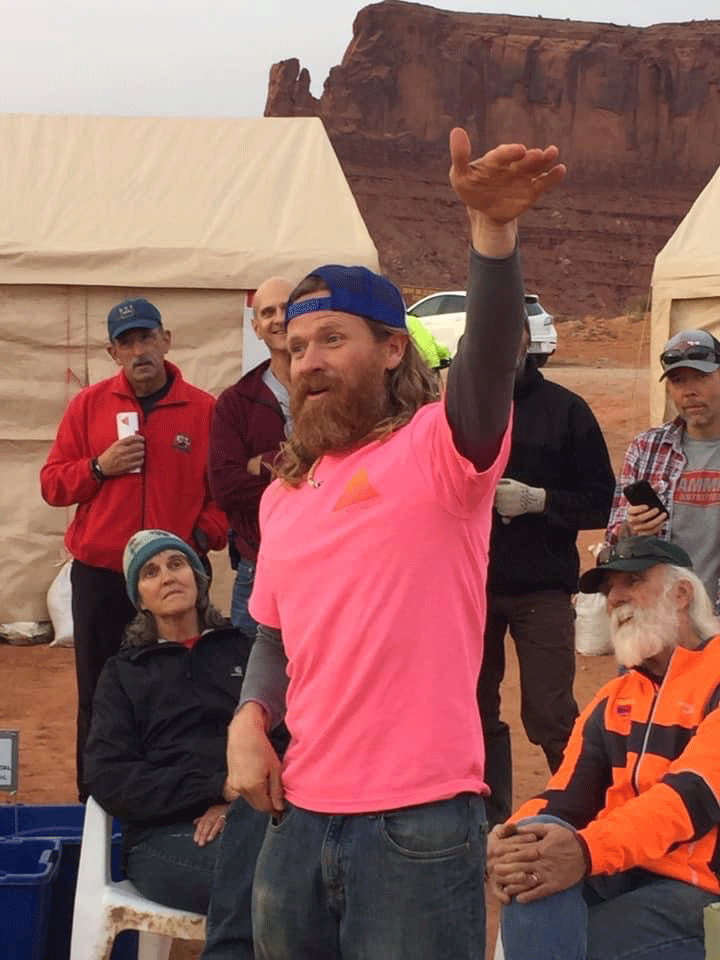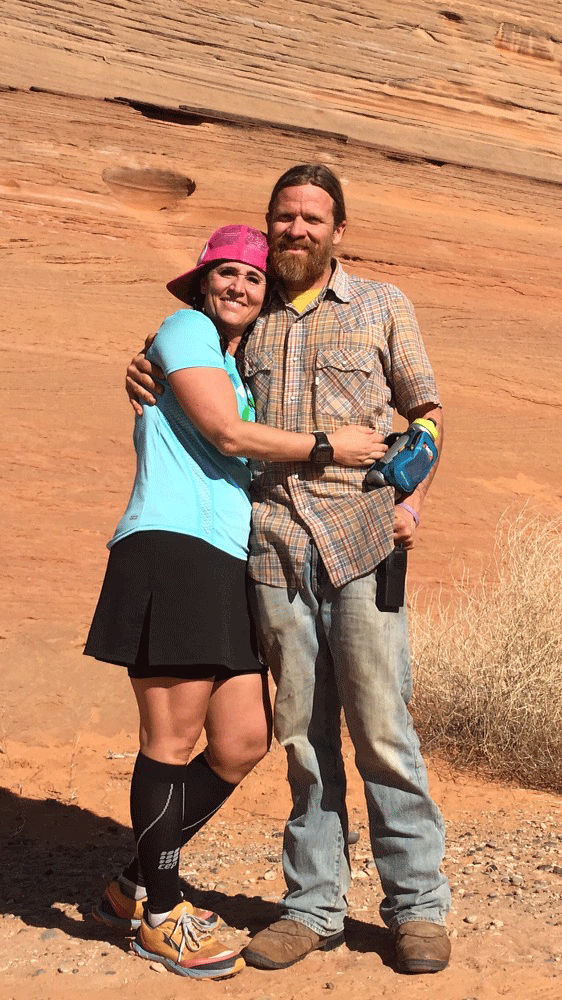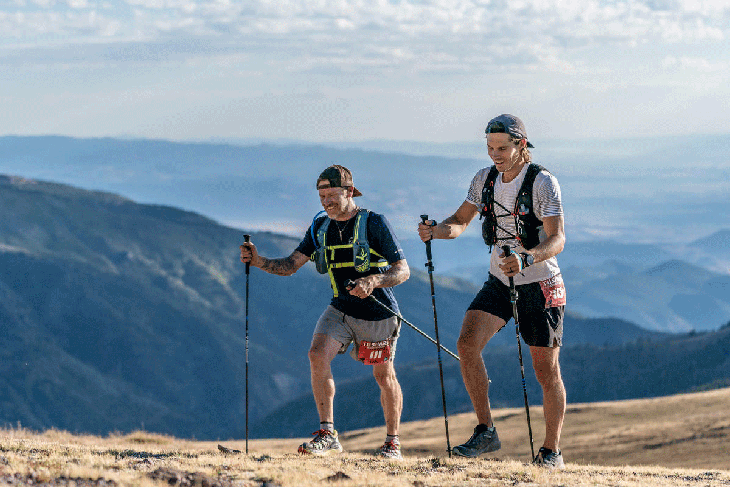New perk! Get after it with local recommendations just for you. Discover nearby events, routes out your door, and hidden gems when you sign up for the Local Running Drop.
Tana Seaford remembers well the first time she met Matt Gunn.
“It was 2013, any my partner and I were at the inaugural Bryce Canyon Ultra to help pace and crew a runner,” says Seaford, of Kanab, Utah. “We were at the runner’s briefing the night before the race. A hundred, maybe two hundred people were standing around and it appeared there wasn’t anyone in charge, so we started to get nervous.”
That was when Gunn, the Race Director, walked into the crowd to stand on a picnic table.
“He looked kind of disheveled, he was looking at a map, and it was clear he was just … all over the place,” Seaford says. “I thought, ‘He needs my help.’”
After the race, which Seaford noted was well-organized if chaotic, she reached out to Gunn. She wound up working on all his races—eight in total by 2016, including Bryce, the Antelope Canyon Ultras and several others owned by Gunn’s southwest-centric Ultra Adventures organization—managing back-end logistics like volunteer organization, packet pickup, even food prep for aid stations.
“He was insistent on having home-made food at his races,” Seaford says. “He was intentional about everything.”
In interviews with Trail Runner and on social-media posts commemorating Gunn over the last week, those who knew him have described his passion for improving the lives of others through humanitarian work; his deeply reserved personality and reluctance to talk about himself; and his close spiritual connection to nature, as well as his appreciation for the Indigenous communities who first occupied the places he loved to explore.
“Intentional” is one word to describe the life of Gunn, of Willard, Utah, who died October 18, 2020, of suicide at the age of 44. In interviews with Trail Runner and on social-media posts commemorating Gunn over the last week, those who knew him have described his passion for improving the lives of others through humanitarian work; his deeply reserved personality and reluctance to talk about himself; and his close spiritual connection to nature, as well as his appreciation for the Indigenous communities who first occupied the places he loved to explore. Organizing trail races, Seaford says, was Gunn’s way of sharing the most beautiful places he knew, making sure others could appreciate their splendor, and to share the culture and wisdom of the Indigenous people from the area.

“He was a selfless person,” says Jamil Coury, Gunn’s friend who himself directs numerous races through Arizona-based Aravaipa Running, “someone who was always looking for ways to help others and do the right thing for communities and the environment.”
In the outpouring of tributes, there is another word that keeps coming up: kindness.
“Kindness was his fundamental belief,” says Toby Ann Gunn, Matt’s wife. “Before anything else, be kind.”
A relationship shaped by adventure
Toby met Gunn in February 2015, when she ran his Monument Valley Ultra. Despite barely knowing each other, Toby and Matt shared an embrace at the finish line.
“The chemistry was crazy,” Toby says. “I didn’t know if he was married or not, he didn’t know if I was married or not.” But Toby described being brought to tears by the beauty of Gunn’s course, and being emotional at the finish. “He told me I understood the meaning behind the miles.”
Toby came back from her home in Northern Utah to run Gunn’s next race, Antelope Canyon, in March, where the finish-line scene repeated itself. She ran each of his races that year, and on January 9, 2016, they went on their first date.
“We went on a run, of course,” Toby says. “Afterward, he came over to my house and we made food, sat, talked and just existed together. It was sealed.”
Gunn introduced Toby to a style of adventure that would set the tone for their relationship, hitchhiking into Mexico’s Copper Canyon for the Ultra Caballo Blanco just two months after that run. One year later, they returned to Urique, where they were married.
Gunn introduced Toby to a style of adventure that would set the tone for their relationship, hitchhiking into Mexico’s Copper Canyon for the Ultra Caballo Blanco just two months after that run.
“We traveled the world together,” Toby says, describing a first-anniversary trip to Colombia where the couple slept on buses rather than rent hotels. “His goal was to see everything he possibly could in the time he was there. He could just come up with a route and connect these cities together very naturally.

“It’s similar to how he could create the best possible course for a race,” she continues. “He could see trails and how to connect them better than other people.”
An Unconventional Race Director
Toby says Gunn’s enduring gift was his desire to share his love of nature in the hope it would be as meaningful to others as it was to him. It was why and Gunn took their six kids—four of Gunn’s and two of Toby’s – camping at every opportunity. It also informed his race courses. Toby describes being brought to a halt by the vista of Horseshoe Bend on the Antelope Canyon course. “I remember thinking to myself, ‘Am I in a National Geographic magazine?’”
“He had a knack for picking beautiful locations to hold events and putting them on event if it was prohibitively difficult or extra work just because he wanted people to see and experience the beauty and toughness of the area,” Coury says.
“He had a knack for picking beautiful locations to hold events and putting them on event if it was prohibitively difficult or extra work just because he wanted people to see and experience the beauty and toughness of the area,” Coury says.
After interviewing Gunn for a profile for Utah’s KSL news website, the writer Arianne Brown was so intrigued that she signed up for the Zion 50K and, later, the Bryce Canyon 50K. She says she was taken aback at the difficulty of the Zion course, which included a rope climb—foreign stuff for Brown, who was more accustomed to cross-country and road-marathon courses. “There is a hashtag, #mattgunnwantstomakeyoucry, and it is totally true,” she says. “His races are brutal—they bring you to your knees and make you want to dig deep.”
According to Brown’s interview with Gunn, he took up running after losing his father to cancer in the early 2000s: he jumped in with both feet, signing up for an IRONMAN triathlon without much background in endurance sports. He discovered trail running when he moved to Ogden for a teaching job, and soon thereafter learned about ultrarunning. He often turned to training when he was overwhelmed, as he was when he returned from humanitarian work in Haiti, feeling he was unable to fix the suffering of the people he’d met there. In 2011, he founded the Zion 100, the first of what would grow to become the Ultra Adventure race series and his full-time job.
Gunn didn’t fit many conventions of a full-time race director. He was reserved, even shy. “I think he was more comfortable sorting the trash than speaking in front of everyone,” Seaford says, recalling the steps Gunn would take—including using composting toilets—to ensure his races created as little waste as possible. “He went through every single piece of trash and anything that could be reused would be. If anyone ever accidentally threw away their glasses at one of his races, I’m sure he found them and gave them back.”
I think he was more comfortable sorting the trash than speaking in front of everyone,” Seaford says, recalling the steps Gunn would take—including using composting toilets—to ensure his races created as little waste as possible. “He went through every single piece of trash and anything that could be reused would be …
Coury recalls the 2015 Tushars Mountain Runs, when Gunn got lost marking his own course. “He spent the night in the woods waiting for the sun to come up just to get back to the staging area.” But, Coury also notes, “He was always focused on a lot of details about his events. He was a visionary type of person with lots of grand plans to change lives.
“He had a lot of ambitions and not all of them worked out, but what he created with Ultra Adventures was pretty amazing,” he continues.
A Deep Desire to Help Others
One of those ambitions was a race Gunn was planning for June 2021, about which Seaford says he was talking to her as recently as a month ago. It would be a return to race directing for Gunn, who returned to teaching after Vacation Races bought Ultra Adventures and he ultimately left the company.
“He loved teaching,” says Toby, who noted the Ogden Preparatory Academy, where Gunn taught Spanish, enrolls an underserved population of students. “He loved working with kids, and he loved having the summers off to run and crew races, to do work with troubled youth programs, and to do as much good in the world as he can.”
Toby says Matt’s humanitarian efforts, including service projects in communities that hosted his races, opened her eyes to another side of Utah. “Coming from Northern Utah, I didn’t even know [Southern Utah] was where the Navajo lived, much less that they didn’t have running water, no flush toilets, and so on,” she says. “He would have service projects down there where we would rebuild sweat lodges. we would build a way for people to have running water. You would come down for the race but that experience, those projects, is where your life would change.”
Toby says Gunn’s deep sense of caring for others made it difficult for him to see the glass as half-full. “He was so troubled by the state of the world,” she says. “He felt like things were out of control, and so often he would know the answer before you asked—‘no, we can’t do that,’ or ‘no, we won’t be able to fix it.’ That outlook and the way he cared were really hard on him.”
He was very sensitive to what’s going on in the world and trying to make it a better place. There was this underlying sadness and sensitivity to what is happening in the world, but I never imagined he was in danger of taking his life.
“He was a deep soul and he had some sadness,” says Seaford, noting that she and Gunn had previously gone through a rough patch at the same time and helped each other through it. “He was very sensitive to what’s going on in the world and trying to make it a better place. There was this underlying sadness and sensitivity to what is happening in the world, but I never imagined he was in danger of taking his life.”
Before he left, Toby says, Gunn made sure to create one more positive impact—he voted.
“He filled out his ballot and left it on the counter for me,” she says. “It was the first time he’s voted in a presidential election.”
“Do a run for Matt”
The weekend before Gunn died, he was with Coury at the Moab 240 pacing a friend of theirs. Posting on Instagram after Gunn’s death, Coury wrote, “If there is anything you can do for Matt I hope it’s to honor his legacy. You can bet we will be celebrating Matt in the Tushar Mountains for years to come. Matt loved the entire Grand Staircase/Grand Circle area of the Southwest. Next time you travel to that region, do a run for Matt.”

Coury also noted, separately, that there was one perk Gunn found to leaving his role as race director. He sent a photo of Gunn running the Tushars 100K this summer. “It was one of his favorite events he created,” Coury wrote in a note accompanying the picture. “And this summer, he got to run it.”